Top News
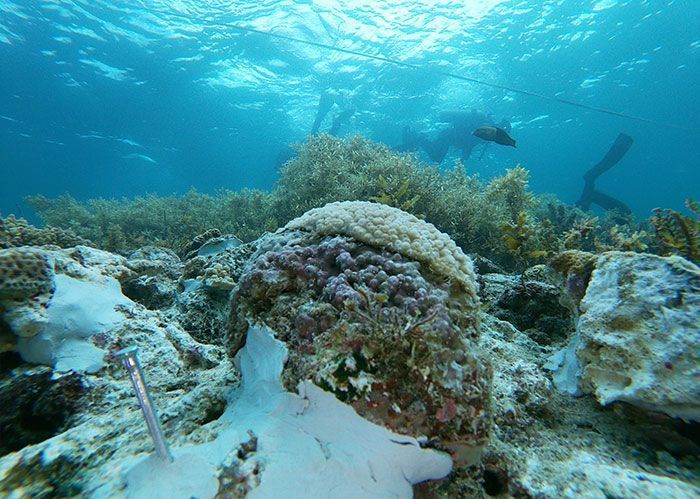
September 15, 2021 Ryukyu Shimpo
The coral reefs spread throughout Oura Bay in Nago City are abundant in diverse coral varieties including Acropora, Poritidae, and Heliopora coerulea. Due to construction of the Futenma Replacement Facility, coral within the zones planned for land reclamation is being transplanted to another area of the ocean. On September 3 a journalist for the Ryukyu Shimpo and Osamu Makishi, representative of the diving team Rainbow, dove into the ocean at the transplantation site and took photographs of the conditions there. Coral to be transplanted are being crushed into small pieces and anchored in place using an underwater adhesive.
Several-thousand-year-old coral can be seen all around in the blue sea [photographs]
In the middle of summer, while the water temperature was in excess of 30°C, the diver Makishi watched the coral transplantation work with his own eyes. He stated with quiet anger, “The high temperature is hard on the coral. An ocean environment having value on a global scale is being destroyed.”
(English translation by T&CT and Erin Jones)

Go to Japanese
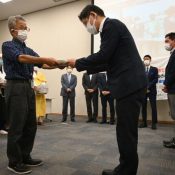
September 15, 2021 Ryukyu Shimpo
Tokyo – On September 14, Takamatsu Gushiken participated in negotiations held at the National Diet with representatives of the Ministry of Defense and the Ministry of Health, Labour, and Welfare, and called for a halt of plans to use soil from the southern part of the main island of Okinawa, which was a battleground in the Battle of Okinawa, in the relocation of MCAS Futenma to Henoko in Nago. Gushiken participated as a representative of the Gamafuya, a volunteer group that collects the remains of those who died in the Battle of Okinawa, and handed over a petition with 33,389 signatures. He argued, “Moving ahead with this plan is a betrayal of the war dead, their families, and the Japanese people.”
During the negotiations, he also asked the Ministry of Health, Labour, and Welfare to perform DNA tests for 52 family members of people who died in the Pacific War.
Taeko Yasuma (Aichi Prefecture) also participated virtually. She is the child of a Japanese soldier who drowned on duty in 1945. He was 29 and a crewmember on a submarine sailing from Okinawa to Saipan. Yasuma called for her father’s remains to be retrieved and for DNA testing to be performed, saying “While I’m still alive, I want to hold my father in my arms, and to lay him to rest with my mother in her grave.”
A representative of the Ministry of Defense repeatedly testified that “The contractor in charge of construction decides the soil that they will use in the land reclamation after the approval of the change. That being said, we believe that the issue of the remains of the war dead is very important.” In response, Gushiken said, “This is the country’s responsibility, not the workers’.”
With campaigning for the Liberal Democratic Party leadership election beginning on September 17, and voting on September 29, Gushiken indicated his intentions to determine opinions on this issue by sending a public list of questions to the candidate likely to become prime minister. He also plans to mail the list of questions to the heads of opposition parties including the Constitutional Democratic Party and the Japanese Communist Party. Gushiken says, “There is no way that this inhuman action can be allowed. The plan must be abandoned.”
(English translation by T&CT and Ellen Huntley)
Go to Japanese
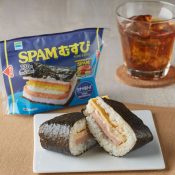
September 15, 2021 Ryukyu Shimpo
Family Mart (Tokyo – Kensuke Hosomi, CEO) started selling a pork and egg musubi “SPAM Musubi – Tuna Mayonnaise” (248 yen, tax included) throughout Japan in August, and it has quickly overtaken staples such as their grilled salmon musubi to become Family Mart’s top selling musubi in August. In just one month they sold over 4 million.
The musubi uses Whole Food’s (US) canned pork product “SPAM,” and combines it with grilled egg and tuna in mayonnaise.
According to Family Mart, around 40% of purchases were women, around 2% higher compared to other musubi. A representative from the company said, “It has a good amount of volume, and can still be bought with one coin even when adding a salad, which may be the reason for its popularity with women.”
Originally, the musubi was sold by Okinawa Family Mart (Naha) in Miyakojima in 2000, becoming an island staple under the name “Pork & Egg Musubi.” It was well received by locals, so it was released nation-wide on August 3 as part of the company’s 40th anniversary of its founding.
Another representative from the company said, “Sales have been better than expected. From now, we want to look into developing some other flavors.”
In Okinawa, the “Pork & Egg Musubi” continues to be sold. A representative from Okinawa Family Mart said, “We are extremely happy that Okinawan soul food is popular throughout Japan.”
(English translation by T&CT and Sam Grieb)
Go to Japanese
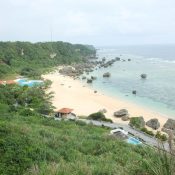
September 13, 2021 Ryukyu Shimpo
The Bora Environmental Protection Committee (BEPC, Kaname Sunagawa, president), made of up of the residents in Bora Gusukube in Miyakojima, and the Miyakojima Fishery Collaboration Association (Hirotsugu Kuriyama, president) demanded Miyakojima City investigate the closing the facilities at Boraga beach and restricting access to the sacred site “Kubakundai (also known as Pumpkin Hole)” on September 3. The same day, Sunagawa handed written appeals from each group to mayor Kazuyuki Zakimi.
According to Sunagawa, “Kubakundai” has been a sacred site for Bora village since long ago, protecting its residents. The stalactite-filled cave is only accessible at low tide, and due to a large stalactite that looks like a pumpkin, it is often called “pumpkin hole.”
According to Miyakojima, a television program featuring the place introduced it as a “little-known gem” and a “place of [mystical] power,” leading to a sudden increase in tourist visitors. According to Sunagawa, in recent years dozens of tourists from outside the island descend upon the site day after day on guided tours. Sunagawa fumed, “This is an important piece of local heritage, but it is being destroyed by tourists. Some of the stalactites are also being broken.”
Additionally, the waters around “Kubakundai” are known to be a good place for fishing, however the increase in tourist foot traffic is trampling the coral, endangering an important habitat for fish in the area.
Sunagawa’s demand to close beach facilities and restrict access to the sacred site is supported by a survey of the Bora resident’s association, in which a majority of respondents agreed with the proposed changes, and he asked mayor Zakimi, “To also consider the local heritage and to protect the natural resources.”
Mayor Zakimi responded, “It was good ocean filled with eels and spiny lobsters. We will work quickly to enact rules that follow the will of the townspeople.” He explained that the city was looking to hire a designated manager for the Boraga beach facilities, and said, “A major precondition for the hire will be protecting nature and adhering to the requests of the village.”
(English translation by T&CT and Sam Grieb)

Bora Environmental Protection Committee president Kaname Sunagawa (3rd from the right) handing Miyakojima mayor Kazuyuki Zakimi (2nd from the right) the group’s written demands – September 3 at Miyakojima City Hall
Go to Japanese

September 8, 2021 Ryukyu Shimpo
Ginowan – At the September meeting of the Ginowan City Council on September 8, the council unanimously adopted a resolution and written opinion opposing the U.S. Military’s disposal of polluted water containing PFAS (organofluorine compounds) from MCAS Futenma in the public sewage system after treating the water. In July, the council had issued a request that the military not dispose of the polluted water in the sewage system, but the U.S. military went ahead with the disposal. The council strongly criticized this action, saying “We are absolutely furious.”
In the resolution and written opinion, the council demands four things: 1) Polluted water containing PFAS absolutely must not be disposed of in the sewage system or the rivers. 2) The U.S. Military must bear responsibility for incinerating the materials, as they have in the past. 3) Firefighting foam must be switched for an alternative product that does not contain PFAS. 4) Firefighting foam, fuel, and the like must be strictly managed in compliance with the law.
The council pointed out that even if treating for PFAS had been done appropriately, “we still have concerns about reputational damage. It has to be said that this action shows a complete disregard for the people of this city.” The resolution will be sent to the office of the U.S. ambassador to Japan, and the written opinion will go to office of the prime minister.
(English translation by T&CT and Ellen Huntley)
Go to Japanese

September 10, 2021 Ryukyu Shimpo
Okinawa Governor Denny Tamaki held a conference at the Okinawa Prefectural Office September 9, where he announced Okinawa’s policy measures for dealing with the COVID-19 state of emergency, which was extended to the end of September. Tamaki explained that Okinawa was past the peak of the current wave of cases, however the healthcare system was still under a lot of stress and continues to restrict outpatient care. He asked the people of Okinawa to spend the end-of-September Silver Week holiday with only members of their household, and to avoid participating in any events. Meanwhile, he also unveiled the three main points of the project to reopen the economy when the time comes.
The Japanese government’s announced that the Novel Coronavirus Response Headquarters decided that the state of emergency, currently in place for 21 prefectures, would be extended for 19 prefectures including Tokyo, Osaka, and Okinawa from September 12-30.
Along with the announcement of the extension, Okinawa similarly announced that they will be extending measure such as asking major business to remain closed on Saturdays, Sundays, and Holidays, closing prefectural offices, requiring restaurants to reduce opening hours and not serve alcohol, asking people to refrain from going out except for necessities, and to refrain from travelling outsides of the prefecture or to other islands.
Prefectural schools will have dispersed attendance through the end of the month based on the level of infections in each region. Club activities will be limited to national and major prefectural competitions, and that clubs will be able to practice after obtaining permission from the principal for two weeks leading up to the competition under certain conditions.
For the project to re-open the economy, the prefecture is assembling a team to investigate how to implement vaccine and negative test result passports. Additionally, they are kicking off a “Protect the children project” and “vaccine promotion and expansion project,” in cooperation with requests to prioritize vaccines for teachers who request them and for students.
Regarding the vaccine passports, Tamaki indicated, “We want to look into an analog solution before turning to a digital one,” and are looking into paper vaccination passports.
Okinawa indicated their goal for reopening the economy would come when new cases fall below 200 per day, an independent goal set by the prefecture, however the Japanese government has indicated they are now treating the improvement of healthcare availability as of utmost importance. Governor Tamaki commented, “I think it is necessary for the prefecture’s targets and the country’s standards for easing restrictions be consistent.”
(English translation by T&CT and Sam Grieb)
Go to Japanese

September 9, 2021 Ryukyu Shimpo
On September 7 the Okinawa Prefectural Government (OPG) requested aircraft noise abatement in the areas surrounding Kadena Air Base and Futenma Air Station. The OPG lodged this request with five people in Japan and the United States, including people involved in the U.S. Forces, Japan and the Ministry of Defense. Among items requested were: setting specific noise abatement measures intended to effectively meet environmental standards; and strict adherence to aircraft noise regulations and Osprey utilization measures agreed upon by the Japan-U.S. Joint Committee. This request is lodged yearly along with collected noise measurement results, and this year the request was mailed in the post to prevent the spread of the novel coronavirus.
In 2020 in noise level measurements conducted by the OPG and the governments of local municipalities, 6 of 19 measurements collected around Kadena Air Base exceeded the level stipulated by environmental standards, and 2 of 11 measurements collected around Futenma Air Station exceeded this level.
The request is being sent to the commanding general of the III Marine Expeditionary Force with headquarters in Okinawa, the U.S. consul general in Okinawa, the director of the Okinawa Defense Bureau of the Ministry of Defense, the ambassador in charge of Okinawan Affairs of the Ministry of Foreign Affairs, and the director of the Water and Air Environment Bureau of the Ministry of the Environment.
(English translation by T&CT and Erin Jones)
Go to Japanese
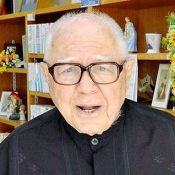
September 8, 2021 Ryukyu Shimpo
LaSalle Parsons, Catholic priest and president of a local group to deliberate life, death and aging (Sei to Shi to Oi wo Mitsumeru Kai) died of old age at 6:43 p.m. on September 4 at a monastery in Oroku, Naha City, at the age of 90. He was born in New York. The funeral service will be held on September 9 with only monks present.
Father Parsons came to Okinawa as a missionary in September 1958. For 30 years since 1959, he guided students at a collegio in Shuri-Sakiyama-Cho, Naha City. In 1990, he became the president of the Naha Group of Amnesty International and the director of the Okinawa Human Rights Association, where he dedicated himself to human rights and anti-war peace efforts. In 2014, Parsons coordinated a project to send letters to then President Barack Obama to petition the construction of the new base in Henoko, Nago City.
(English translation by T&CT and Monica Shingaki)
Go to Japanese
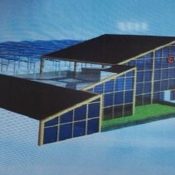
September 7, 2021 Ryukyu Shimpo
By Wu Li Jun
Okinawa Products Enterprise Corporation (OPEC, Naha, Tomoaki Haneji, president) has imported farming technology from Taiwan, and are continuing on constructing a plant factory in Tomigusuku. They are planning on getting it operational this year, and hope to have their first harvest as soon as January 2022. Similar to other gardening facilities, it will cultivate organic vegetables using sunlight and hydroponics. Most plant factories in Okinawa rely on artificial light sources, so one that uses natural sunlight and hydroponics is rare. The produce they raise will be sold to mainland Japan, and they are aiming for it to be a new “product” for Okinawa.
The plant factory will have 990 square meters of floor space, and will be built with a 4-meter-tall reinforced steel frame. A special high-durability vinyl was imported from Taiwan, which will be used to cover the walls and roof, and will help regulate the temperature and humidity of the growing environment. Starting with bitter melon, the factory plans to grow produce such as tomatoes, sponge gourds, bell peppers, and melons.
Since the vinyl being used allowed sunlight to pass through it, the factory will have much smaller electrical costs compared to facilities that rely entirely on LEDs for light.
The plant factory being built by OPEC will be operated by a subsidiary, O.T. agriculture (Hiroiwa Miyagi, representative director), and are planning to use it as a model for similar plant factories throughout Okinawa.
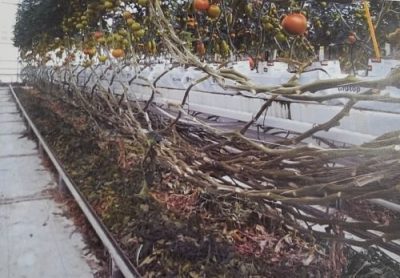
An example of the growing set up being prepared by the Okinawa Products Enterprise Corporation
According to Miyagi, hydroponic plant factories produce faster than traditional gardening. Tomatoes that are grown in soil usually ripen for harvest twice per year, however the factory anticipates a harvest eight times per year. Since their ability to use natural light is a significant cost-cutter, they can also set the price for their produce lower.
Miyagi stresses, “Mass production allows you to sell produce at a lower price, so we can compete with produce grown outside of Okinawa. Since Okinawa has few value-adding industries, this can also contribute to Okinawa’s economy. I want this new plant factory to build a new industry in Okinawa.”
(English translation by T&CT and Sam Grieb)
Go to Japanese
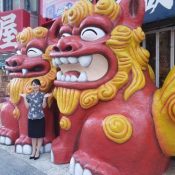
August 30, 2021 Ryukyu Shimpo
Okinawaya installed giant Shisa statues that reach over three meters in height in front of their flagship store on Kokusai-dori in Makishi, Naha, delighting both Okinawans and tourists who visit the street.
Each statue weighs 300 kilograms and reaches a height of 3 meters and 30 centimeters, and the two combine measure around 4 meters across. The statues are original characters by Okinawaya, which were designed and manufactured 13 years ago, and have been in storage at a heavy machinery company for a long time.
The two statues are intimately huddled together in front of the store, and have been given the name, “Okinawaya LOVELOVE Shisa.” The effects of COVID-19 continue to create a harsh economic environment in Okinawa, but a representative from the store thinks, “They are big, but are cute and have smiling faces. I want [the statues] to provide some positive energy in these times.”
(English translation by T&CT and Sam Grieb)
Go to Japanese
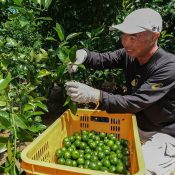
September 2, 2021 Ryukyu Shimpo
It is currently the best time to harvest unripe shikuwasa, a fruit commonly used in cooking and known for its characteristic refreshing aroma. On the morning of September 1, farmers in Kijoka in Ogimi, the center of Shikuwasa production, were out in the fields using special scissors to cut the fruit one-by-one from the trees, careful to avoid damaging the fruits.
According to the farmer Takeshi Oshiro, unripe shikuwasa will be harvested through the end of September. The majority will be shipped out of Okinawa. Wiping his brow, Oshiro says, “I want to create a stable supply system.”
(English translation by T&CT and Ellen Huntley)
Go to Japanese














 Webcam(Kokusai Street)
Webcam(Kokusai Street)


